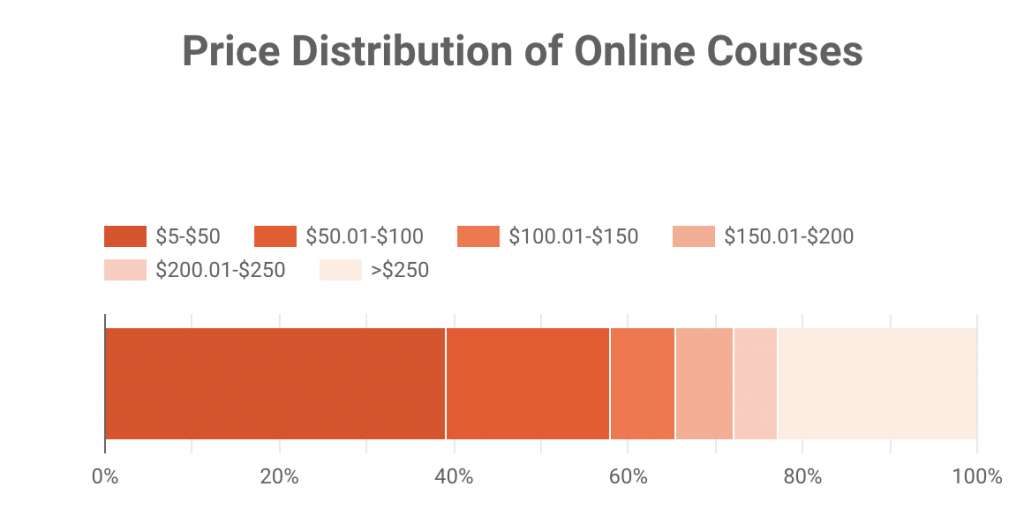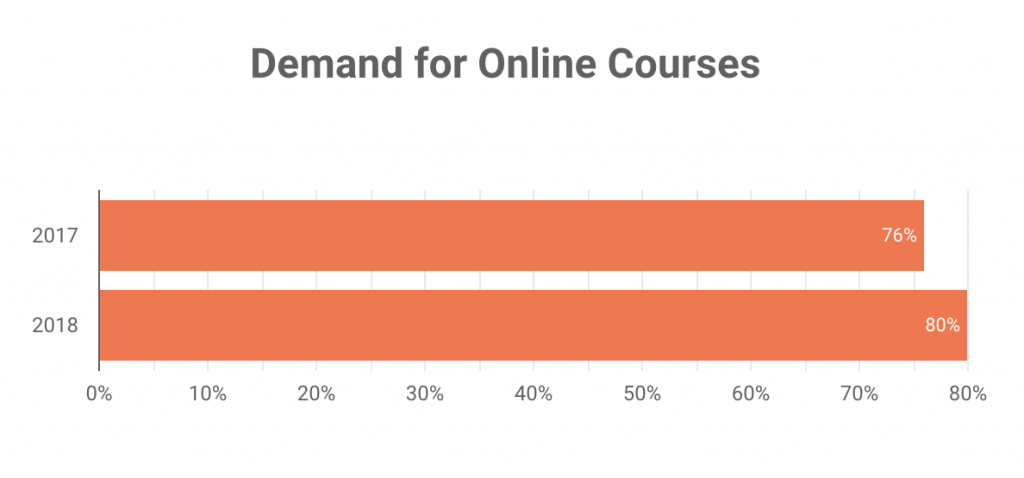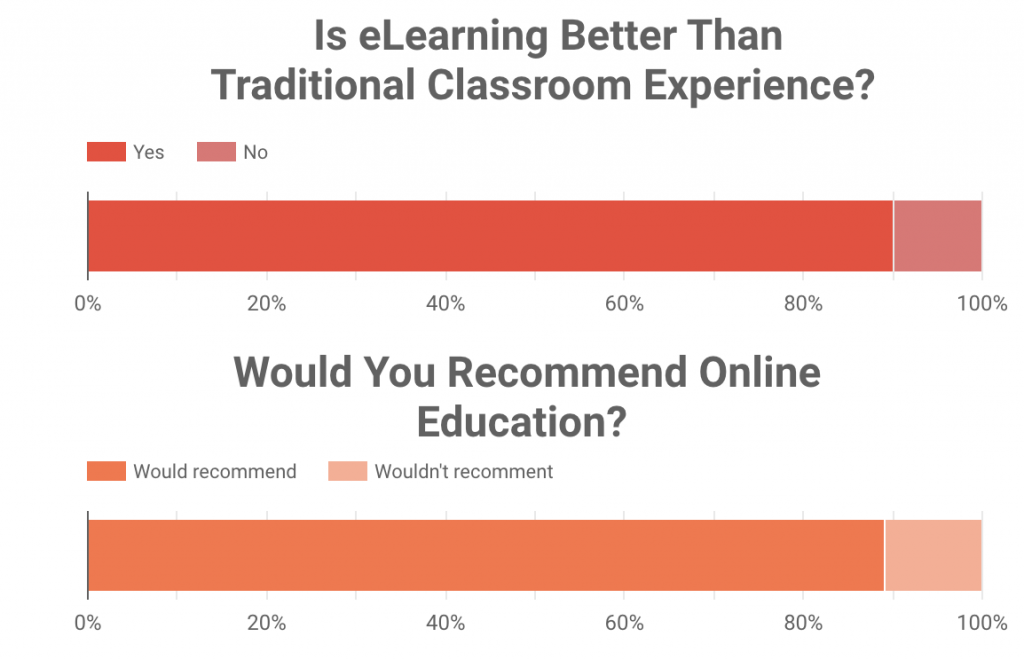The famous Italian artist Michelangelo once said: “I’m still learning.” This means that the learning process is a never-ending journey if a person wants to keep on growing. Thus, it’s no wonder not only students but also workers pay attention to learning and development (L&D).
The concept of eLearning isn’t new. The history of online education dates back to 1924 when the first testing machine was invented. It was the first device that allowed students to test themselves in a classroom.
However, a lot has changed since then: there’s no need to go to college and attend lessons to study subjects, gain knowledge, master skills, and discuss course-related matters. In plain English, physical presence doesn’t matter anymore. In 2019, everything you need to study is at your fingertips: gadgets and connectivity.
What is more important,[pullquote]the new generation is here: colleges, universities, and companies should be ready for Gen Z, tech natives who use their devices every day.[/pullquote]
So, isn’t it the rise of eLearning? If you’re unpersuaded by the above-mentioned ideas, also recall facts and statistics.
Here’s the list of eLearning facts and statistics everyone should know in 2019:
Table of Contents
- 1. Modern Education Goes Digital
- 2. Mobile Learning is on the Rise
- 3. eLearning Saves Time and Money
- 4. Self-Improvement Market Grows
- 5. Online Education Adapts to Lifestyle Better
- 6. eLearning Improves Retention Rates and Grades
- 7. Online Education Guarantees Higher Engagement
- 8. Distance Education Gets Popular among Adults
- 9. AI Improves Student Experience
- The List of Online Courses for STEM Students
- In a Word
1. Modern Education Goes Digital
Over the last few years, the educational system has changed a lot. Although most students believe in the importance of human interactions, face-to-face lessons go digital: Around ½ of all classes are done online, 5.8 million of American college and university students (almost 30% of the total number) are enrolled in some form of distance education, and 50% of all higher education will be delivered online by the end of 2019.
Back in 2012, when massive open online courses (MOOCs) started gaining in popularity, there were just 5 options on the market. In 2018, over 900 universities around the world launched 11.4k MOOCs.

What is more, 67% of all students believe that video, blogs, and other online media are important teaching tools. Yes, online education comes in various forms and formats, for example:
- Webinars
- Podcasts
- Flipped courses
- Online courses
- Educational apps
- Video games
With a variety of these forms, it’s no wonder that 15.4% of students are enrolled exclusively online, and this number is kept on growing. Moreover, people are interested in machine learning disciplines like few shot learning and IT professions which means the importance of digital methods of education.
2. Mobile Learning is on the Rise
The days when your computer was the one effective way to take online courses are far behind us. Today, people can study on the go: With the growing number of mobile users (4.68 billion), it’s no wonder that mobile learning market is growing, too. It’s predicted that it will reach $38B by 2020:

For people, this means more opportunities to obtain knowledge with the help of their smartphones as companies launch more and more educational apps to suit their target audience even if they choose to study acoustics. This also means that online learners are in charge of the educational process: Once you pick courses that interest you, do them in your spare time.
3. eLearning Saves Time and Money
Since students want to enjoy the college years for full, they try to save time with time management apps for homework. However, online education allows students to save 50%-70% of time and money. One study has analyzed the data from 448-course sales to find out that 77% of online courses fall within the $5-$250.00 range:

With online courses, you ensure that the right person gets the right information at the right time, so it takes less time to obtain knowledge. On average, an online course is 25-60% shorter than classroom training on the same subject.
What is more, the world-known universities offer a great variety of online courses for free which means every person can enroll in a course to gain knowledge. Who else wants to save time and money? eLearning is a great way to kill two birds with one stone.
4. Self-Improvement Market Grows
The educational process is not just about college students; it’s also about modern workers who believe in the power of learning and development for personal and career growth. In fact, 87% of people believe that having professional development or career growth opportunities is important to their decision of whether to stay or go. And for 68% of workers, learning and development is the most important workplace policy.
Why? The job market is searching for smart, innovative, and creative workers who can stand one step ahead of their competitors. Thus, online education helps people obtain knowledge and improve professional skills, and therefore stay competitive in the market. What is more, 58% of employees want to learn at their own pace, so online education is right for them. Thus, it’s no wonder that 80% of people saw an increase in demand for online courses in 2018:

5. Online Education Adapts to Lifestyle Better
College years are wonderful: You attend lectures, meet new friends, take part in out of class activities. Although the traditional ways of learning work well for most students, they won’t suit the needs of students who want to keep a work-life balance.
According to one study by Best Colleges, 59% of students surveyed claim that they are employed and have children, so it’s no wonder that over 50% of U.S. students are returning to education after work.
So, wouldn’t it be great if you could study in your spare time? With eLearning, it’s no longer a dream. M-learners have an opportunity to study right in bed: 52% of people study after waking up and 46% of m-learners do it before going to sleep. Thus, it’s no wonder that 60% of respondents report that online courses fit their personal schedule/lifestyle better.

6. eLearning Improves Retention Rates and Grades
If you want to get better grades, you have to understand the subject well. And the understanding of the subject depends on college attendance. Attending classes helps to get in-depth knowledge as it gives you another perspective on the material besides the books. Once you miss a class, it can be harder for you to understand the material which may lead to worse grades or a dropout.
So, what’s the solution? eLearning, of course.
For first-time degree-seeking students who have enrolled at 4-year degree-granting institutions, the average retention rate is 81%. However, providing students with in-person and online courses institutions can lead to higher retention and graduation rates (by 9-10%).

If you want to solidify your understanding of the subject, you can give online courses a try. [tweetthis]Elearning is a great way to work on your gaps and get a better understanding of a topic. [/tweetthis]. The bottom line? Taking online courses in community colleges helps students be better prepared and more motivated.
7. Online Education Guarantees Higher Engagement
A Gallup student poll has found that student engagement decreases in nearly every progressive grade level: just 34% of Grade 12 students feel engaged. In other words, it’s harder to engage older students in the educational process.
However, there’s a way out: Modern students love interactive educational concepts, so they are more likely to take an online course that offers educational methods that engage (videos, gamification, quizzes, etc.).
Any proof needed? One research by Livestream has revealed that 68% of teachers claim video content stimulates discussions and 61% believe it’s preferred by students.
Want to know more? 90% of students believe eLearning is better than traditional classroom experience and 89% of them would recommend online education, so it goes without saying that it stimulates student engagement.

8. Distance Education Gets Popular among Adults
Being a well-rounded person is trendy these days. People want to obtain knowledge and master skills, and it’s never too late to learn.
Case in point:
Guadalupe Palacios was 92 when she enrolled in a literacy program. Maureen Matthews started a three-year law degree at the age of 79. Vinnie Dean Walker was the oldest student ever to graduate from Sinclair Community College at the age of 89.
Online education is not just for young students; more and more adult learners give it a try. With the rise of online education, it’s easier for lifelong learners to improve skills and gain knowledge these days. According to Online Education Trends Report, 37% of school administrators note a trend toward older students.

Around 40.9% of students enrolled in some form of distance education are 30+ years of age: eLearning helps older students gain knowledge at their own pace without being judged by others. So, isn’t it perfect for lifelong learners?
9. AI Improves Student Experience
Today, Artificial intelligence (AI) is an important part of our lives, and it also has an impact on the educational industry. A recent US Education Sector report says that AI in U.S. education is predicted to grow by 47.5% from 2017-2021.
Why? When studying offline, students should keep up with classmates. However, each student has his/her own strengths, skills, interests, and needs. Thus, it’s important to personalize learning.
When it comes to online education, most teachers agree that the artificial intelligence (AI) trend helps to improve student experience (64%) and personalize learning (60%), according to the University Business survey.

With the help of AI, students can get the best possible assistance: Teachers can provide students with quick feedback. All in all, it allows teachers to find an individual approach to every student, and therefore trigger interest, encourage student engagement, and improve grades.
The List of Online Courses for STEM Students
For most students, STEM classes require much time, effort, and knowledge. However, this education gives many career opportunities, so it’s important to overcome a fear of STEM, and online courses can make you fall in love with the exact disciplines like Algebra, Physics, Chemistry in an interesting and interactive way. If you’re interested in online courses for STEM students, here’s my list of the best ones for fans of science:
General
- Basic Science: Understanding Experiments
- Basic Science: Understanding Numbers
- Discovering Science: Science Writing
- Inspiring Young People In STEM: Feedback Tools for STEM Ambassadors
- Teaching STEM Subjects: Differentiation for Learning
- Representing Data with Images and Sound: Bringing Data to Life
Mathematics
- An Introduction to Recreational Math: Fun, Games and Puzzles
- Linear algebra
- Maths Subject Knowledge: Proportional Reasoning
Physics
- Electricity and Magnetism
- From Atoms to Stars: How Physics Explains Our World
- Solar Energy
- Surface Science: Methods of Surface Analysis
Chemistry
Biology
- Evolution of the Human Sociality
- Exploring Cancer Medicines
- Introduction to Psychological Research Methods
- Introduction to Clinical Psychology
Programming
- Algorithms Specialization
- Introduction to Data Science in Python
- Introduction to Programming
- Functional Programming in Scala Specialization
Accounting & Economics
- Accounting and Finance
- Accounting for Decision-Making
- Financial Market Analysis
- Finance and capital markets
Statistics
In a Word
With the growing demand for online courses and a great variety of online teaching methods, eLearning is the future of education. Not only does it save your time and money, but it also helps to obtain knowledge and improve skills that matter to you.
Have you ever enrolled in online courses? What are your thoughts on the eLearning trend?